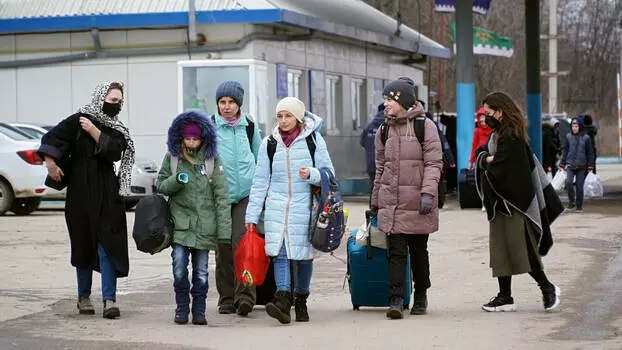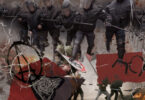Although Moldova, a republic of roughly 3 million inhabitants located along Ukraine’s southwestern border, is not directly involved in the Russian aggression against its northern neighbour (and, hopefully, will remain uninvolved for the foreseeable future), the war dominates public debate across the country.
It has raised a number of pressing issues, such as how to better manage the flow of Ukrainian refugees entering the country every day. Accommodating them (90 percent are housed outside of state-run shelters, a fact that is both inspiring and scary given the risks involved), their safety while moving (more than 80 percent of adult refugees are women, now vulnerable to trafficking, extortion, and sexual assault), their safe transportation to other destinations (two-thirds of refugees only passing through Moldova on their way to other, mostly EU countries), supplying food and basic items like clothing and hygiene products or specific medical services such as dialysis, insulin, and oncology — all these require considerable effort from Moldovan society and authorities.
Although the public response to the refugees has been mostly positive (to the extent that, after the effort was lauded in the foreign media, some members of the so-called “creative class” began pushing for “hospitality” to be the country’s new touristic branding), some of the issues require not only social solidarity, but also structural policies and state interventions that would help families hosting refugees, the refugees themselves, and also provide a basic social safety net for everyone in the country, refugees and hosts alike.
The needs of the refugees and the challenges facing the host country change daily. Initially, the most pressing issue was to provide refugees with a warm meal and a roof over their heads. Six weeks later, besides food and shelter, there are other important issues to be solved: long-term housing, financial support for the refugees and the families hosting them, as well as education and employment for the refugees that choose to stay in Moldova for a longer period of time.
There is also the question of how to deal with other consequences of the war: the constant price increases (bread, for example, became 10 percent more expensive in February, while electricity is expected to increase by more than 30 percent), inflation (18 percent in February compared to last year), and economic stagnation (GDP is expected to shrink by at least 5 percent in 2022 as a result of the war). These come on top of other unresolved problems: the pandemic is not over and exacts a heavy toll every day (despite being overshadowed by the war), while the entire population remains vulnerable to natural gas and electricity price rises.
Hanging above all of these issues, however, is the much larger question: is Moldova the next target? Six weeks after the start of the Russian invasion, there is no clear answer.
Moldova’s Mini-Donbas
One of the main factors influencing how the war is viewed in Moldova is Transnistria, a breakaway region that declared its independence as the Pridnestrovian Moldovan Republic (PMR) in 1991 following disagreements over the future of Soviet Moldova and a short military conflict, in which the Russian 14th Army intervened. Both sides opted for a ceasefire in 1992, although they chose not to take any steps towards resolving the conflict or making life easier for their citizens (who have relatives, go to work, and study on both sides of the border). Although not recognized by anyone except the breakaway states of Abkhazia, South Ossetia, and the self-declared Republic of Artsakh in Nagorno-Karabakh, it has functioned as a de facto independent state ever since.
The Russian military presence is still very real — the 14th Army was transformed into the Operational Group of Russian Forces (OGRF) and counts up to 1,500 personnel. Part of this force, up to 400 soldiers, guards the Cobasna ammunition depot. Another part is involved in the Joint Control Commission, a trilateral peace-keeping force comprised of Moldovan, Transnistrian, and Russian forces. It also provides military training to the Transnistrian Army, which itself counts some 5,000–6,000 troops.
Since the beginning of the war, the separatist region in the east of the country has been under constant scrutiny. Ukrainian authorities regard it as a possible bridge from which a Russian offensive could be launched against Odessa — indeed, there was talk of forces in Transnistria joining Russian forces from Crimea to encircle Odessa. Consequently, the Ukrainian military heavily damaged the railway bridge in Kuchurhan that connects Odessa and Chisinau, and closed all border crossings between Transnistria and Ukraine on 28 February.
On the other bank of the Dniester, in Chisinau, authorities have adopted a prudent attitude, emphasizing that, on the one hand, the Moldovan government is watching the situation closely, while on the other hand saying that, at least for now, it does not see any signs that Transnistria is looking to escalate the situation in the region.
In Transnistria itself, the authorities have purposefully worked to keep the situation calm. Since the beginning of the war, the breakaway region’s government has consistently sought to convince everyone that not only is Transnistria not interested in destabilization, but in fact will do everything it can to prevent it. Thus, unlike Moldova, Transnistria has not introduced a state of emergency and has declared itself ready to help refugees fleeing the war. It is clear why: in a sense, this is the only viable position for the Transnistrian authorities. With Odessa and access to its ports blocked, the region is left economically vulnerable.
For despite the stereotype that Transnistria is completely dependent on Russian money, the everyday economic reality is quite different: what keeps the de facto state afloat is not ideological support from Russia, but rather business transactions with Ukraine and EU countries. In 2021, the countries of the Eurasian Economic Union — Russia, Belarus, and several Central Asian states — accounted for only 10 percent of Transnistrian exports, while Moldova, the EU, and Ukraine accounted for the remaining 90 percent. Almost half of Transnistrian exports (46 percent) are related to the Rybnitsa Metallurgical Factory, which exports mainly to the EU.
These harsh economic realities that make Transnistria dependent on Ukraine, Moldova, and the EU also make the prospect of an escalation in Transnistria very unlikely. After all, Transnistria would stand to gain very little, while risking everything.
A New-Found Love for Neutrality
Since the beginning of the war, Moldovan authorities have emphasized that the country will adhere to the foreign policy orientation prescribed by the country’s constitution: to maintain neutrality at all costs.
Indeed, neutrality has become the watchword in the official reaction to the war. However, different political camps interpret it differently. For the ruling party, the Party of Action and Solidarity (PAS), neutrality means, on the one hand, refraining from any involvement in the war to the extent that Moldova has even banned military items such as bulletproof vests from being sent to Ukraine through Moldovan territory, but also active condemnation of the war, with the country supporting the UN resolution demanding that Russia immediately end its military operations in Ukraine.
For the parliamentary opposition, the Electoral Bloc of Communists and Socialists (effectively right-wing conservative parties that exploit the legacy of the Soviet period for electoral purposes), neutrality has a more passive meaning: not only refraining from any military assistance, but also abstaining from voting in the UN (which the government did) and from joining the sanctions against Russia (which the government is not doing anyway).
There are also groups for which neutrality represents (and has always represented) a weakness that should have been abandoned a long time ago. On the nominal Right, these are groups that support NATO and Moldova’s unification with Romania. On the nominal Left (but nevertheless right-wing in terms of economic and social policies), these are groups that want Moldova to support Russia’s war efforts.
For most of Moldovan society, however, neutrality is seen as the best and only protection against a war that seemed improbable, but now at times appears inevitable — especially when the howling of air-raid sirens from neighbouring Ukrainian cities can be heard all along the border.
An Alarming State of Emergency
While remaining neutral in terms of foreign policy, in terms of domestic policy the Moldovan authorities have hardly been neutral, playing an active role in designing and maintaining a “secure” public sphere. Thus far, this has meant new restrictions on Russian media and growing scrutiny of politicians who publicly support Putin’s aggression or praise the Russian army and its actions in Ukraine.
A state of emergency was instituted in the country on 24 February (like many other countries, Moldova has been in one type of state of emergency or another since the beginning of the pandemic). The state of emergency included regulations on the rights of Ukrainian citizens in Moldova and the creation of facilities to host them, but also introduced limitations on disseminating information, especially with regard to media outlets reporting on the war.
One of the consequences of this “pacification” of the media sphere was the blocking of Sputnik, the Russian state-owned radio broadcaster, on 26 February. It was a bold move, considering how early on in the war it was executed. But it was also a problematic one — the Security and Intelligence Service (SIS) did not offer any elaborate proof that Sputnik had indeed violated regulations concerning war reporting, nor did SIS argue convincingly why blocking (as opposed to a fine, for example) was the appropriate sanction. SIS merely included Sputnik in a list of media that disseminated information inciting war. On the same day, Sputnik’s website was blocked in the country, and several days later the Romanian-language editorial team resigned.
While Sputnik has very few friends and followers that will mourn its cancelation, the fact that SIS can block any website without justification or explanation of the proportionality of the “crime” and “punishment” is a matter of serious concern. It is not difficult to imagine a situation in which SIS can block other media sources that do not conform to the vaguely defined term of “not disseminating news and articles that incite war”.
Moreover, this policy is hardly neutral. By only targeting websites that promote the Russian narrative, authorities ignore the warmongering from the other side. Thus, Moldovan media in the “anti-Russian” camp have extensively covered the war in a way that glorifies military action, normalizes murder and killing, justifies the killing of Russian soldiers and their allies, praises the participation of Moldovan mercenaries in the war, and calls for Moldovan politicians with “pro-Russian” sympathies (whatever that means) to be arrested pre-emptively. By tolerating incitement to war from one camp while blocking it in the other, the Moldovan authorities are hardly acting in a neutral way. Militarism should be limited and blocked on all sides.
The Fallout to Come
The war will change Moldovan society for years to come. Of course, it is difficult to estimate the magnitude of the changes, but at least a few seem to be a foregone conclusion.
There will most likely be a heated public debate about the neutrality of the country, its relationship to NATO and the EU, and, more generally, its militarization and military spending. Some figures are already arguing that Moldova should have a better and larger army. The debate over militarization will most likely interfere with discussions about education, healthcare, and social security systems.
Anti-Russian sentiments are another potential issue. This is especially important given the fact that most of the Ukrainian refugees staying in Moldova right now are Russian speakers, and Russian is indeed the language in which volunteers, society, and the state communicate with them. Although Ukrainians constitute the second-largest ethnic group in Moldova, there is almost no Ukrainian educational or cultural infrastructure in the country, and until this changes, Ukrainian refugees mostly opt for Russian-language schools.
While most people in Moldova distinguish between Russians and the Putin regime, there are many signs that a growing swathe of the population views Russians in general, and Russian-speaking groups in the country in particular, with suspicion. If not nipped in the bud, the “hunt” for Russian agents in the media, the political sphere, and across the country could escalate into a toxic environment where expressing dissenting views could easily place you on the wrong side.
The article has originally appeared on Rosa Luxemburg Stiftung website, as part of the War / Peace – Ukraine Crisis thematic series.
CC BY-NC-ND 2.0, Photo: UN Women / Produced by UN Women Moldova.










Thanks Vitalie, your articles always are helpful to understand the Moldovan complexities without the usual commonplaces. The PAS-regime with its policy of banning “Rusian”” symbology deemed as “warmongering”, even Soviet symbology, is part of a stinky trend and it’s easy from abroad to consider the PAS policy as a Plahotniuc-type of governance using its majority to “capture the State” with the tacit or blatant support of the European Union.